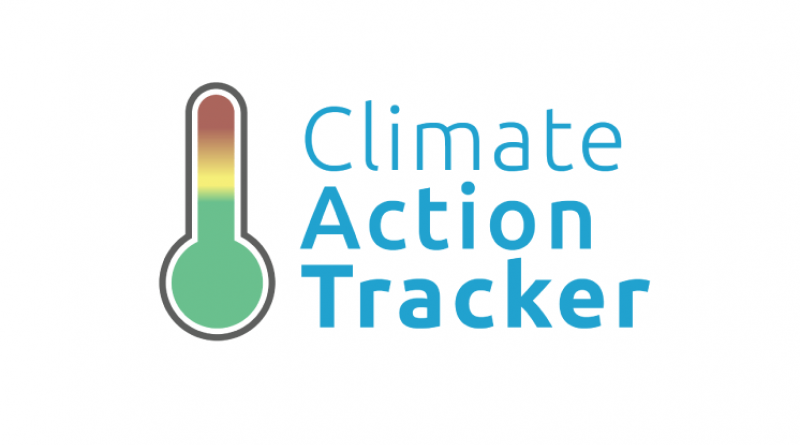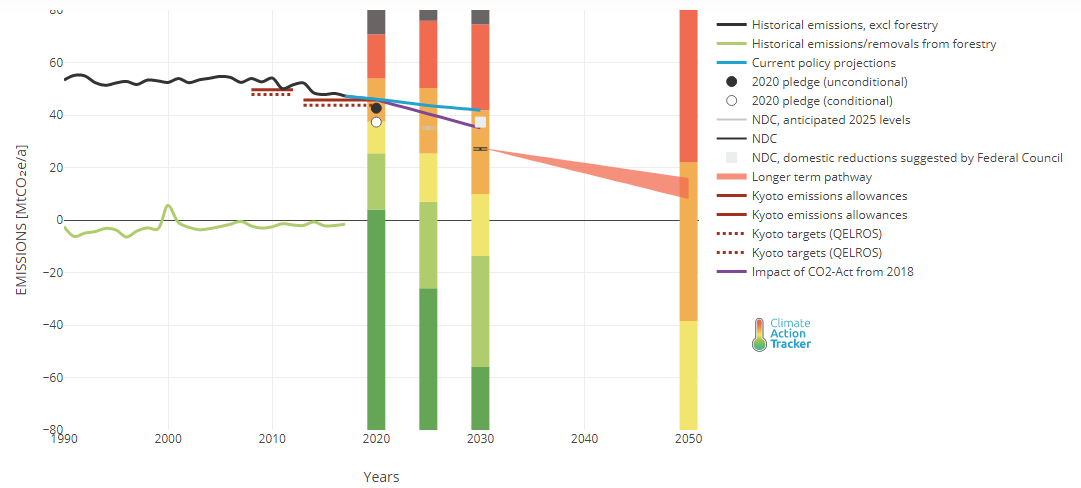Climate Action Tracker: The case of Switzerland.

Switzerland is in the process of completely revising its CO2-Act, its key piece of climate change legislation. The current draft is stronger than the version that the National Council failed to adopt in December 2018. This main purpose of this revision is Switzerland to achieve its insufficient 2030 NDC target of a 50% emissions reduction from 1990 levels (of which 60% must be achieved through domestic emission reductions). With all countries needing to update their NDC’s with higher ambition by 2020 it is to be noted that a 1.5° C compatible target would need a much larger NDC commitment than 50%, with domestic Swiss emission reductions of at least 50% alone, with a larger commitment to reduce emissions abroad.
One of the major instruments to reduce emissions is the carbon levy on fossil fuels whose level can be adapted to accelerate emissions reductions. The level of the levy depends on the emissions intensity of the respective fuels. At CHF 96 (USD95) per tonne of CO2 currently it is already among the highest in the world. The CO2-Act amendment under discussion would allow increasing it further to the maximum level of CHF 210 (USD209) should Switzerland not be on the trajectory compatible with meeting its emissions reduction goal.
While the adoption of the amendment of the CO2-Act would allow Switzerland to meet its (insufficient) 2030 emissions reduction goal, reducing domestic emissions by only 30% is significantly below what needs to be done. Keeping in mind its capability to reduce emissions, Switzerland should be at the forefront of climate mitigation committing to the highest possible level of emissions reduction and update its NDC in 2020 to be consistent with the Paris Agreement.
Much more action is needed especially in the transportation sector, responsible for almost a third of Switzerland’s emissions. Despite an increase in emissions in this sector since 1990, no major, sector-specific policy to reduce emissions has been introduced – to the contrary, the penalty for importing cars with emissions higher than those prescribed in 2012 was significantly reduced in 2017. While the Roadmap Electric Mobility 2050, adopted in late 2018, establishes a goal of increasing the share of electric vehicles to 15% by 2022, the document has no legal character and the goal is far from what can be perceived as ambitious.
In August 2019 Swiss Bundesrat also adopted emissions neutrality goal by 2050. This goal is to be engrained in the Climate Strategy 2050 that should be finalized and submitted to the UNFCCC by the end of 2020.

We rate Switzerland’s 2030 pledge as “Insufficient”. The update of the NDC offers an opportunity to increase Switzerland’s level of ambition and improve this rating. For full details see pledges and targets section

The currently implemented policies would result in emissions reduction by 22% in 2030 which would result in Switzerland failing to achieve its NDC pledge. However, currently Switzerland is discussing a number of measures, which – when implemented – would allow the country to meet its emissions reduction goal:
The Energy Strategy 2050 was adopted, by referendum, in May 2017, and contains a package of measures aimed at increasing energy efficiency, reducing CO2 emissions, and steadily replacing nuclear energy by renewables. Many of these measures were included in the reform of the Energy Law that went into effect in January 2018.
Reduction of emissions in the transport sector, responsible for a third of all emissions, is particularly important. The more worrying is the slow trend in electrification of its transport sector. in 2018 around 3.2% of all vehicles sold in Switzerland were EVs. In the half of 2019, the share of EVs increased to 4.8% - slightly higher than in the European Union. Despite this uptake, their share remains significantly below that of some countries with a comparable level of income (e.g. 13% in Sweden, 10% in the Netherlands, 61% in Norway).
In September 2019, the process of adopting a revised version of the CO2 Act began. If adopted, it will enter into force in 2021. The Law includes a number of measures that may accelerate emissions reduction, including increasing the CO2-levy if emissions reduction goals are not met, application of the levy to air travel, and increased funding for energy efficiency measures in the building sector.
Another positive development was the announcement in August 2019 of the goal of the emissions neutrality by 2050 by the Swiss government. The goal is to be further specified in the Climate Strategy 2050 that is to be adopted by the end of next year. For now, the graph continues to show the 2050 target included in Switzerland’s NDC of 70%–85% below 1990 levels by 2050.

*For more graphs & countries visit Climate Action Tracker here
25 October 2020
Climate Action Tracker




